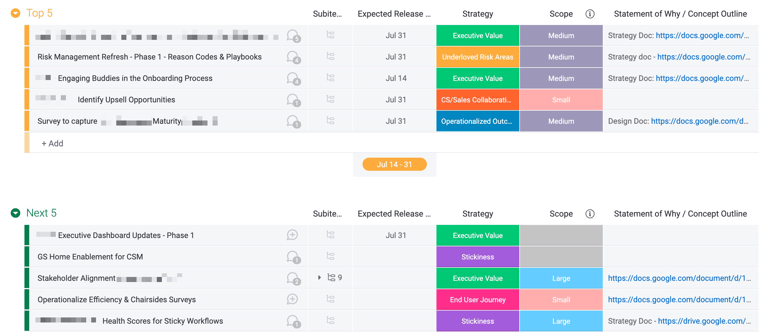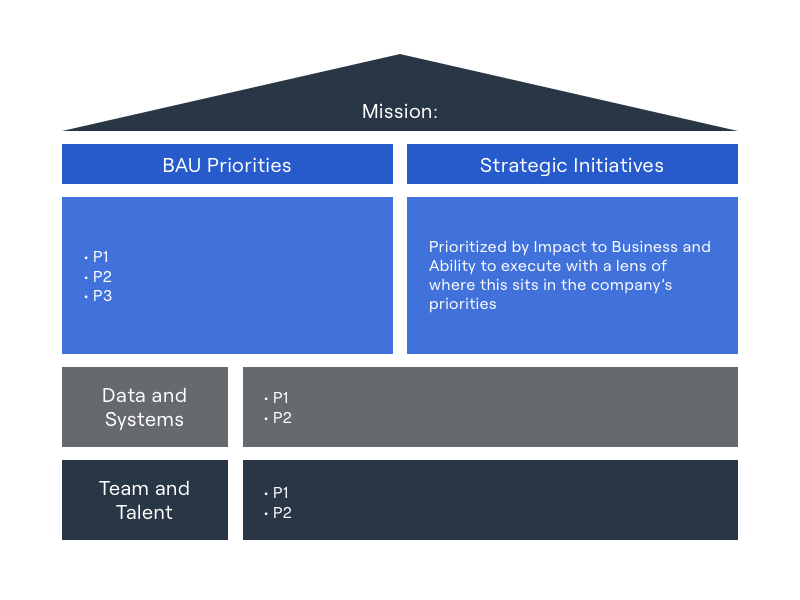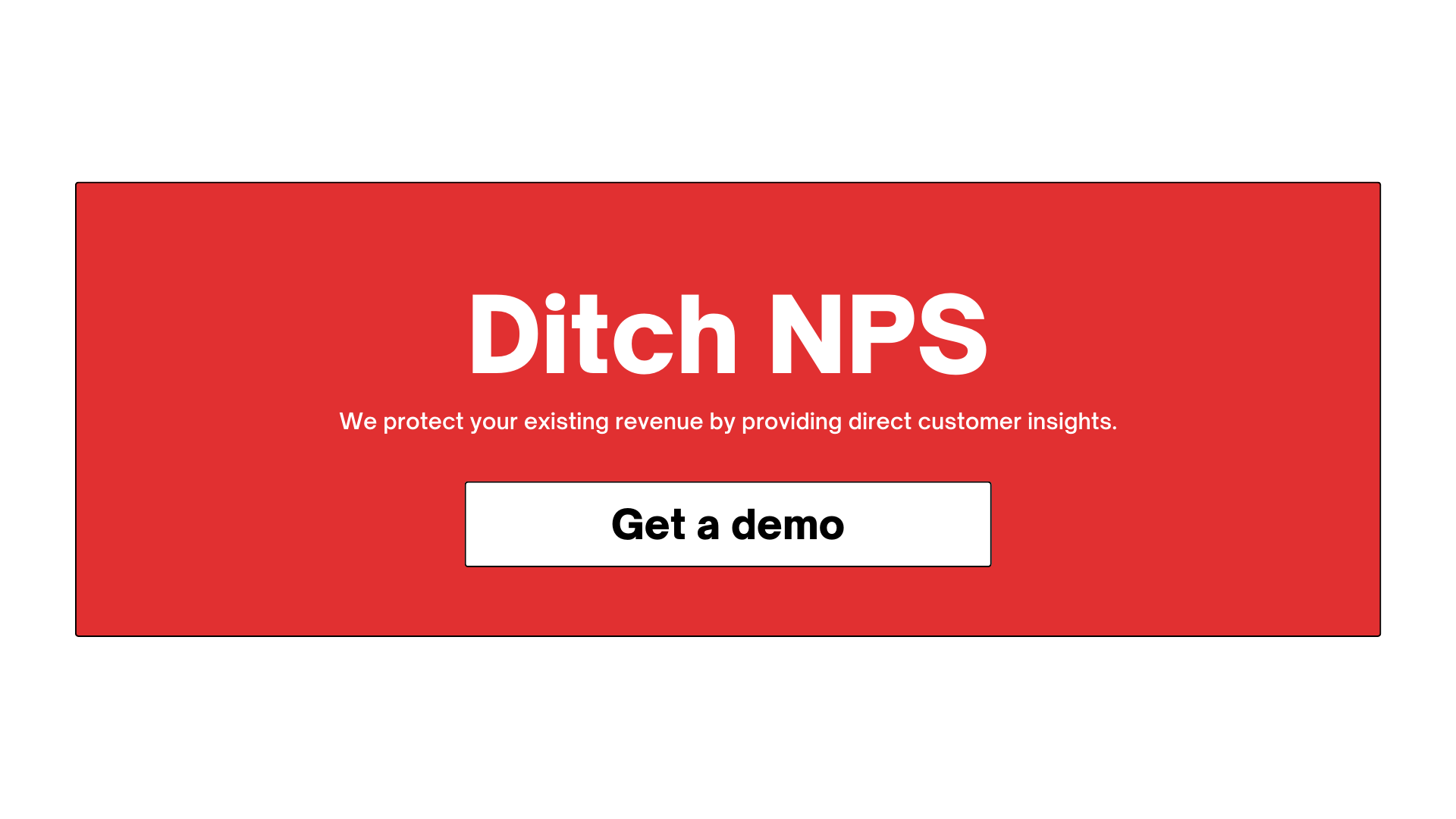Strategic CS Ops teams are the backbone of a proactive Customer Success function.
The average CS Ops team is focused on delivering a more efficient Customer Success operation. Often the scope of the team includes tools, processes, reporting, and forecasting. But for CS to play a more prominent role in the company, the CS Ops team must evolve to own both operations and strategy.
That future of Customer Success, which we refer to as 2.0, requires leaders to spend less time on running a better Success team and instead focus on using customer data to run a better company. That means arming other executives with the customer data they need to make better decisions (pricing, ideal customer profile, product roadmap, content, etc), which will lead to the biggest improvements in retention improvement.
Without a mature CS Ops function, the CS leader is left with anecdotes, NPS, usage data, and health scores to drive decisions, which most other execs will ignore.
So in this article we’ll explore how a CS Ops team matures, including reporting structure, scope of ownership, and metrics—and we hope to inspire you with 1-2 things you can do this quarter to level up your CS Ops team.
A special “thank you” to Gainsight for teaming up with us on this piece, and everyone who contributed to this article by way of interviews and feedback: Zeina Marcotte, Jeff Beaumont, Seth Wylie, Alisa Melville, Jeff Justice Williams, Beth Yehaskel, Richard Adams, Ben Timmons, Jaakko Iso-Järvenpää, Andy Mowat, Lea Boreland, Paul Reeves, Boaz Maor, Daniel Rose, Alex Farmer, Stephen Danelutti, Jeff Heckler, Ed Powers, Emily Garza, David Ellin, Edgar Ramirez Vilchez.
What should CS Ops own?
CS Ops is the team that provides standardization, intelligence, planning, and ultimately strategy for Customer Success.
We interviewed 30+ companies of different sizes to create the table below. This represents the broad scope of potential responsibilities of your CS Ops team. Later we’ll discuss how CS Ops increases responsibilities as it matures—with the aspiration of adding “Strategy” to the most advanced teams.
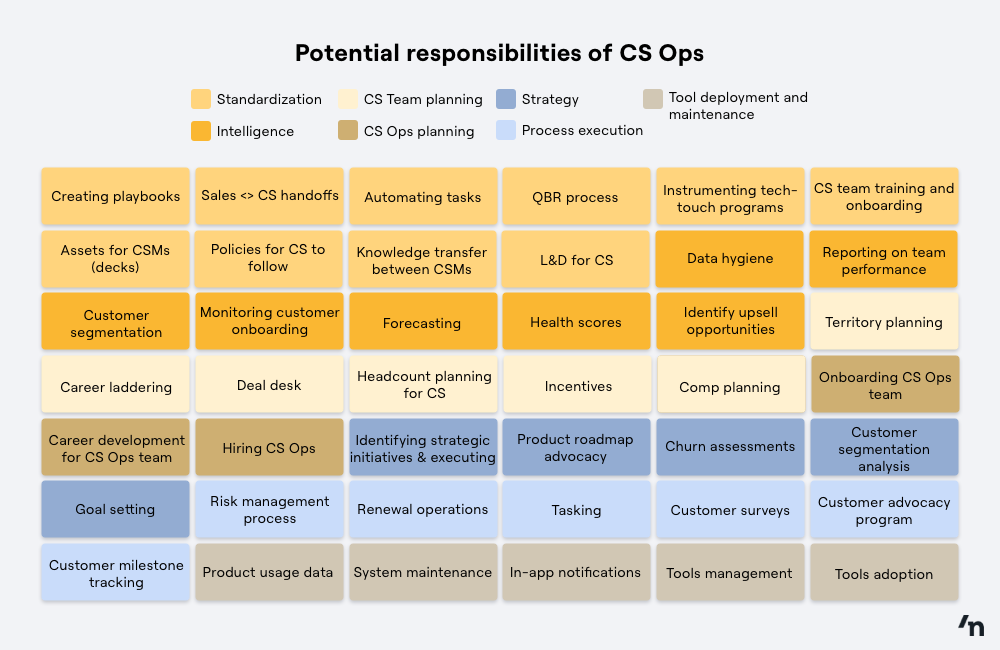
Most CS Ops teams follow a similar path as they mature: the team is born out of a specific CS need, they begin taking on more responsibilities, and then they take action to become proactive.
Where should CS Ops report?
Most companies have one of three structures: CS Ops reports under the CRO, the COO, or the CCO. Before we share a path for deciding on reporting structure, here are some of the common arguments for and against each scenario.
Note: CS Ops is increasingly centralized under a RevOps function that includes Sales Ops, Marketing Ops, and CS Ops. For this article, we’ll focus on which executive owns this Ops group.
If CS Ops isn’t a part of RevOps, you can model your CS Ops reporting structure by comparing it to your Sales Ops team. For example, if Sales Ops reports to the CRO, then CS Ops should report into the CCO.
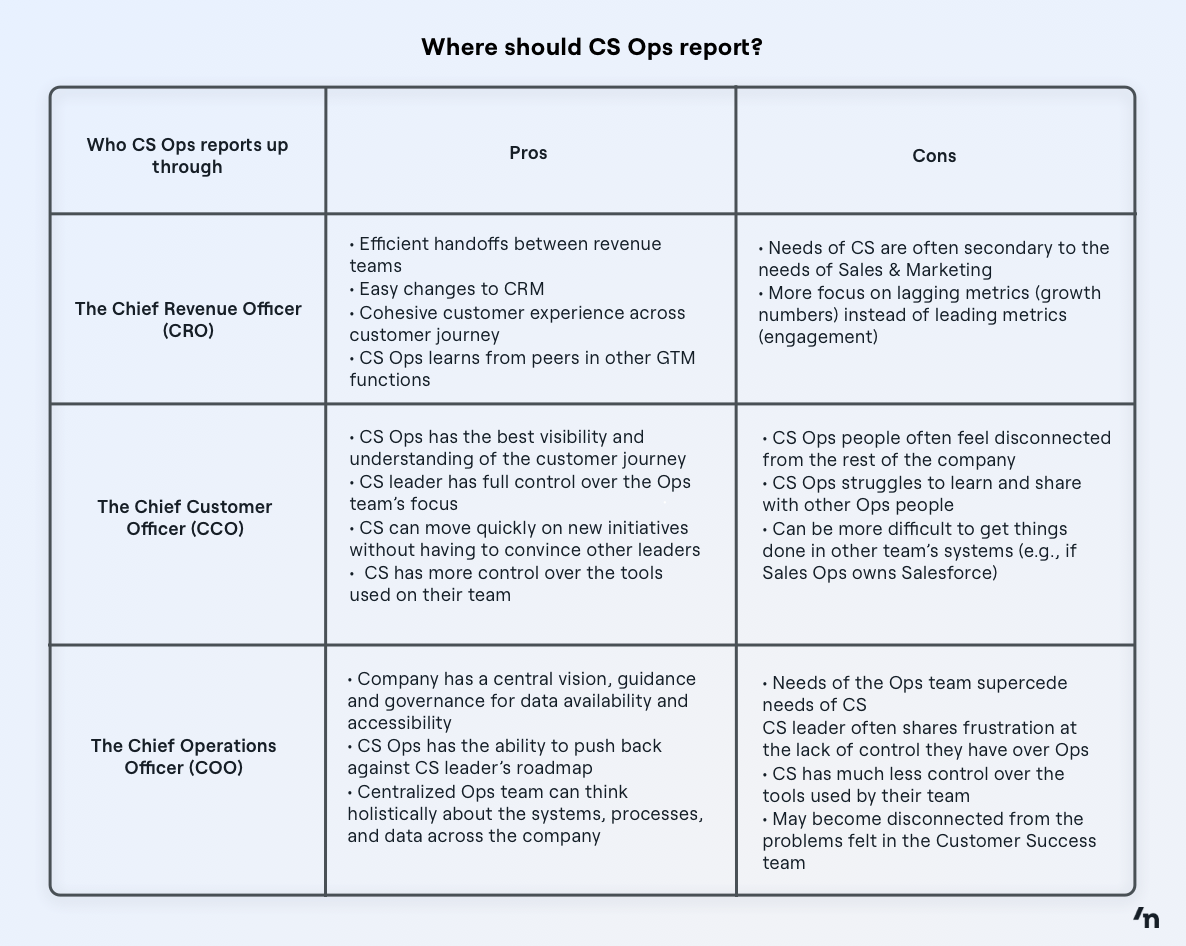
Centralized
If under the CRO or COO, this usually means Ops is centralized under a RevOps or company-wide Ops team. A prominent argument for having a centralized Ops function is the holistic business view it provides: instead of being siloed within Customer Success, CS Ops in a centralized team has visibility into what’s working for other teams. They can also easily work with other Ops members to ensure the handovers between teams are efficient.
You’ll hear more arguments against having CS Ops report to the CRO than the COO. Oftentimes if CS Ops is nested under Sales, the team “shares” responsibilities with Sales Ops…. And inevitably the Customer Success team’s tasks will not be the first priority. The obvious solution is to have clearly defined responsibilities between CS Ops and Sales Ops. Still, if RevOps reports to the CRO then the CRO has final say over their roadmap. And unless other agreements are made, the CCO simply doesn’t have full control.
When reporting to the COO, you’ll usually see a structure where CS Ops reports into the COO but has a dotted-line matrix structure to the CCO. In this case, CS Ops straddles both the operations and CS teams. This encourages 1) the freedom to advise CS without fear and 2) alignment between CS Ops and CS, whom they serve.
Another advantage of reporting to the COO: the needs of CS Ops (such as resourcing or program spend) can be highlighted to both the CCO and COO, thus creating more visibility.
One other strong argument for *not* having CS Ops report into Customer Success is the ability for CS Ops to push back on the priorities of the CS leader. They might want to push back because the CS leader has unrealistic expectations of what’s involved in a project, or CS Ops sees other initiatives as having a greater impact on the team and company. Not reporting into the CCO gives CS Ops the ability to be a thought partner to the CCO.
A counterpoint to that argument: “A good CS Ops leader should be able to push back on the CS leader’s strategy, even if they report into CS.” We can talk theory all day but common sense says it’s easier to debate with someone who is not your boss.
Decentralized
Three points usually surface when arguing for having CS Ops reporting to the CCO:
- First, CS leaders want full control over the Ops team’s roadmap. This is in part due to the pain they feel when CS Ops doesn’t report to CS and their priorities get moved behind others.
- Second, CS leaders have freedom to choose and experiment with tools, allowing Success to iterate towards the best solution quickly.
- When CS Ops is embedded in CS, they have a more nuanced view of the pain points and processes that could be improved. They’ll also have a closer relationship with the people that’ll be most impacted by their work.
CS Ops people that report into the CCO generally say that they wish they could learn from other Ops people at the company. They feel like their personal growth is limited. And since other Ops teams are also overloaded, it’s slow/difficult to make changes in systems owned by those teams (e.g. Sales Ops owns SalesForce).
Deciding on team structure
CS usually hires the first Ops person when there’s a specific problem, like implementing a CS tool, that needs to be solved (more on the “stages” of Ops below). It makes sense for the team to stay nested within Customer Success as it begins to grow: it’s taking on more operational and tactical work based on specific needs the team sees within CS.
But there are signs it’s time to move CS Ops from within CS to a centralized function that reports to the COO. Namely, when every team is working in their own data silos, there’s no single source of truth, and it’s hurting the company’s ability to take action—those are signs it’s time to make a structural change.
|
💡 Compare your team with how other CS Ops teams are structured We’ve started a database of CS Ops team structures here, which includes the roles within CS Ops and where CS Ops reports at different companies. You can anonymously submit your team’s structure through the above link to help other leaders benchmark their teams. |
How does CS Ops mature?
Stage 1: There’s an acute need from Customer Success
CS Ops is often born out of the need to implement tooling. The first CS hire might be able to band-aid together the software they need, but at a certain point the job requires a greater investment.
|
💡 Hiring your first CS Ops role From Jeff Heckler, Global Head of Customer Success at Pipedrive “Even at scale, the skill sets and focus of an Ops function will depend on your business model—if your company serves tech-touch and medium-touch market segments where you have tens of thousands of customers, you’re going to need Ops people who are good at analyzing a lot of data to see where process improvements can be made. “If you’re serving enterprise customers on the other hand, the ability to analyze large amounts of data is less important. You might need someone that’s good at listening to customer calls and identifying points of friction, creating onboarding plans, and transferring that knowledge across the team.
“No matter the business model, I’d say the ability to wire up and manage Customer Success software is necessary and the ability to report on metrics is too. Other than that, having experience running drip campaigns and email nurtures, or building out training programs, are all bonuses when hiring in CS Ops.” |
Most CS Ops teams own “data and systems administration” because that’s the first and foundational part of their role. They can’t be strategic if things are breaking; the team must be sure that the right tooling and data infrastructure is in place so CSMs can do their job.
Some CS Ops teams at this stage will have already started doing some strategic activities, like proactively reporting on customer risk or CSM performance so CS leaders know where to focus their attention.
Stage 2: CS Ops becomes a reactive “everything department”
Once the “acute need” has subsided, the team will start taking on a growing amount of responsibilities. Whenever someone asks, “Could someone help me with this?” Ops is the go-to. Updating the health score calculation, training CSMs, or configuring in-app notifications for tech-touch programs are all examples of tasks that start overloading the CS Ops team.
The tendency in this stage is to become reactive; “the everything department.” As CS Ops grows, they must stay focused on the responsibilities they can and cannot take on, and create a planning process for larger initiatives.
Editor’s note: We stole “the everything department” phrase from Rav Dhaliwal (Venture Partner at Crane). Thanks, Rav!
|
💡 Staying focused in Stage 2 From Seth Wylie, Director of CS Ops & Admin Community at Gainsight For CS Ops teams to be successful in this stage, they must create a single-source-of-truth roadmap. It needs to be based on input from executive priorities, team manager struggles, and CSM input—and it needs to be communicated back to all three groups. Here’s an example of how our roadmap looks:
|
There are 4 areas of responsibility that CS Ops may take over in stage 2:
- Analysis and reporting. There are ongoing and one-off tasks here: ongoing reporting to leadership around portfolio and team performance, and then one-off requests to answer questions from the team (which can be answered in partnership with the data science team if appropriate).
- Foundational team processes (aka “running the business”). This includes ongoing operational and tactical work, like team enablement (do CSMs have playbooks?), segmentation, territory/compensation/headcount planning, and implementing policies.
- Automating tech-touch programs. Teams that serve a large long-tail customer segment will need to instrument campaigns that serve those audiences. CS Ops may help by a.) analyzing data to inform the customer journey, or b.) implementing campaigns to help customers along. Some teams have a content marketing resource on the CS Ops team, which is especially useful if the Marketing organization doesn’t have retention-based goals (i.e., they’re less willing to spend time writing content for customers). In an ideal situation where Marketing does have goals that map to retention, CS Ops can partner with a content marketing or product marketing resource to create the webinars, articles, and other resources that’ll be sent to customers in the scale program.
- Team and talent for CS Ops. Since CS Ops is growing to meet these new demands, they’re also now responsible for managing their own team’s hiring, onboarding, and processes.
|
💡 On CS Ops bandwidth: “Many companies are not as well-staffed in CS Ops as they could be, and the role of CS Ops is often pretty broad. Given the many asks that come our way, the team needs to be smart about planning and creative in scaling its capabilities to create more leverage. Turning common questions into docs, running office hours, creating dashboards for self-service reporting… The mentality of ‘how can I multiply my reach’ is important in CS Ops.” — Zeina Marcotte, Customer Success Strategy & Operations at LinkedIn |
Stage 3: CS Ops becomes a strategic advisor to Customer Success
There are two major changes required to move a CS Ops team from Stage 2 to Stage 3. The team needs to move into a centralized Ops function that reports to the COO, and they must add “strategy” to their responsibilities.
Moving CS Ops to a centralized Ops team under the COO
A fully mature CS Ops team serves as a strategic thought partner to the Customer Success leader. At this point they tend to report into a centralized Ops function under the COO for two reasons:
- Being part of a centralized team under the COO helps ensure handovers between teams are efficient, and
- CS Ops can effectively bring their view of the business to strategize with the CS leader (and push back when appropriate).
There is one downfall here: pulling CS Ops out of the CS team into a centralized function means that Enablement can no longer live within the Ops team’s scope. Even if the team is “embedded” in CS by way of meetings, they’re no longer the experts in CS and so enablement needs to be passed off. By this time, CS usually invests in a dedicated Enablement team that lives within the Customer Success department.
Note: This is when it becomes especially helpful for CS Ops leaders to have a background in CS. The more CS Ops can intuitively understand what their CS leader is thinking, the tighter that alignment will be.
Adding “strategy” to the team’s scope of responsibility
While a Stage 2 team asks, “How can we make the CS team ‘run better’?’” the Stage 3 team asks, “What can we do to move the needle on our goals?” The focus is still on improvement, but it’s more about identifying opportunities and placing bets than just iterating on how the team currently works.
Stage 3 CS Ops teams enable CS leaders with the data they need to drive decisions across the company. For example, they might:
- Bring data on the Ideal Customer Profile (ICP) in different cohorts to drive decisions around who Marketing and Sales should be targeting,
- Share win/loss data to drive pricing discussions with Marketing, or
- Report on the customer requests that Product could build to drive the highest impact on NRR.
The analysts on the CS Ops team must have a working knowledge of statistics to find the signals within the noise.
They use data to provide strategic recommendations to the CS leader. And then depending on the project, they may also be the team executing on the recommendation. For example, we’ve heard of teams who incorporate “strategic bets” in their annual planning — these “bets” are the projects that vary most year over year.
|
💡 How LinkedIn’s CS Ops team plans their priorities From Zeina Marcotte, Customer Success Strategy & Operations at LinkedIn
1. Foundations These are the things you must get right because nothing else can move forward without them. The two categories that fall into this bucket are:
2. Business As Usual Priorities (BAU Priorities) This category usually includes ongoing responsibilities that have been and stay with CS Ops, things like annual headcount planning, territory building, QBRs. These are the basic expectations of the team. 3. Strategic Initiatives Only when the foundations and BAU are tackled do you get to move on to the fun strategic projects. Here we prioritize by looking at what is the most impactful work and what is our ability to deliver on it. We also add a lens of what is most important for the business right now? Where does this fall on the company’s overall priorities? These projects could be things like rethinking service models, exploring paid services, thinking through scale and partnerships, rethinking accountability and the appropriate metrics for the business. Given the maturity of the CS Ops team, you may be able to specialize roles on the Data & Systems side so the rest of the team splits their time between BAU (~60%) and Strategic Work (~40%).
|
In summary, here’s how CS Ops teams mature:
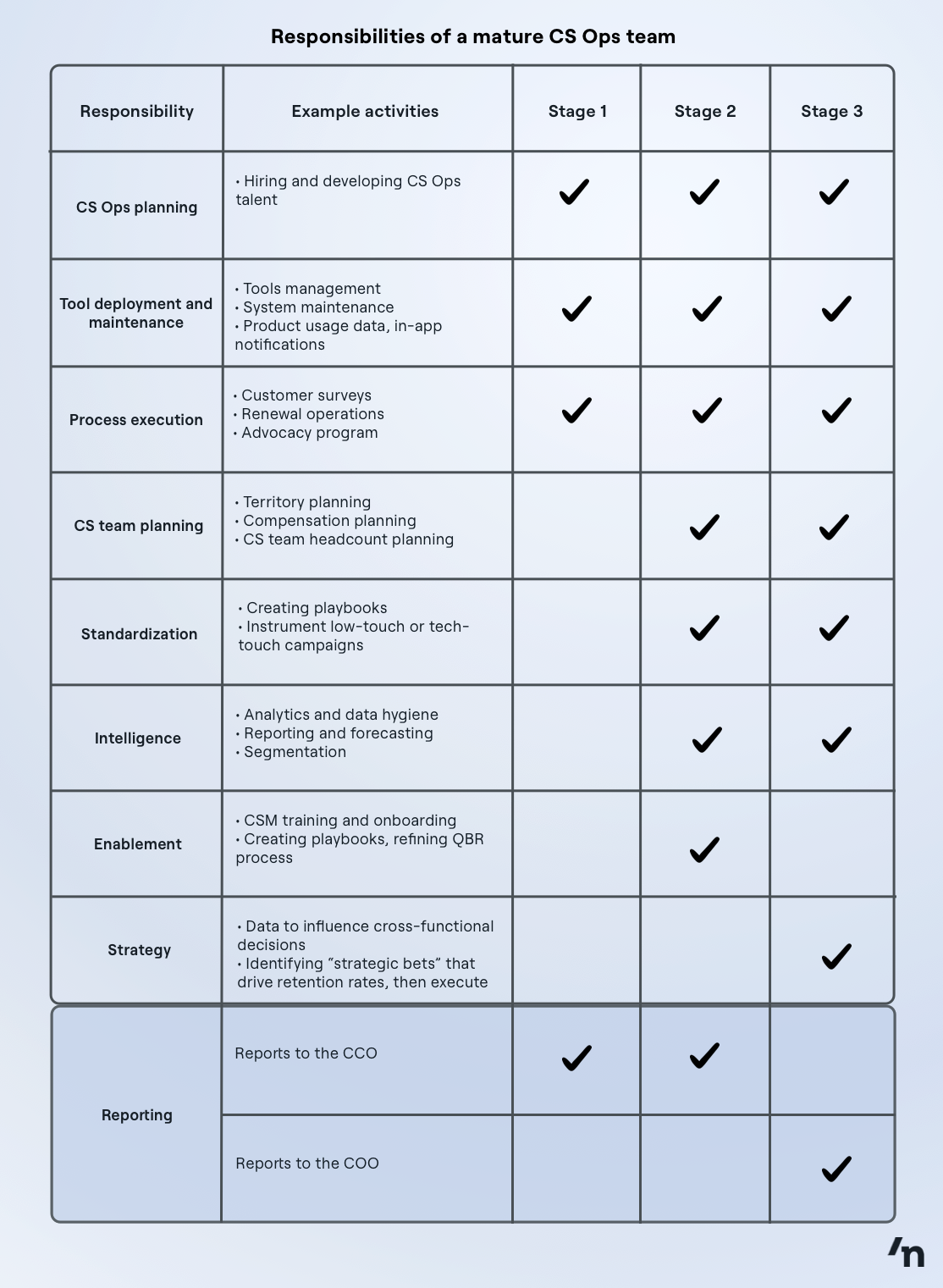
Measuring CS Ops
The CS Ops team’s goals should be aligned with the Customer Success team’s goals. Customer Success has an OKR of driving a certain percentage increase in NRR, CS Ops should have initiatives that contribute to that goal.
How the Ops team directs their focus is straightforward, but “quantifying” an Ops team’s impact requires more effort. Two good options:: 1. Survey CSMs to identify friction with tools and processes, or 2. Calculate cost savings from CS Ops’s work.
1. Survey CSMs to identify areas of friction (and track improvements)
Some CS Ops leaders will survey CSMs to identify areas of pain, gauge the severity of those problems, and then track improvements after changes have been made.
|
💡How to think about surveying CSMs From Jeff Beaumont, Director of CS Operations at GitLab
How I think about surveying CSMs will differ based on the company, team, and current goals. However, the basic questions fall into these themes: Periodic NPS Question: “On a scale from 1-10 with 10 being outstanding, has CS Operations sufficiently served your needs?” Purpose: The goal being to establish a cadence of “are we improving quarter over quarter or year over year?” If our score ticks up, that’s a good thing. If it’s dropping or is stagnant, that’s an indicator that either CS Ops is missing or setting poor expectations, or we have a lot of new employees who may need help. CSM Advisory Board (CAB) (Note: these questions are generally arranged around the CSM tool, though can be modified for anything) Questions:
Purpose: To assess and understand the CSMs view of and depth of usage of the tool. It also means transparency for leadership (CS and CS Ops) into what CSMs are needing.
|
2. Calculate cost savings to quantify the ROI of initiatives
Calculating cost savings works for any project that reduces the amount of time spent on recurring tasks.
|
💡Here’s how Alisa Melville, Senior Customer Success Operations Manager at PagerDuty, calculates cost savings: We start by calculating the amount of time spent by CSMs on processes that could be automated or significantly improved with CS Ops support. (For example, CSMs spending hours creating decks that could be templated by Ops or CSMs spending significant time compiling account data for their book of business when reports could be automated by Ops.) Based on these time estimates and average CSM salaries, you can calculate the associated cost. Then, I pair this against the time needed to manage one additional account in a CSM's book of business (or average amount of CSM time consumed per customer). If we can reduce these time-sucking inefficiencies, how much more time would a CSM have? And how many more accounts could they manage based on that newly available time? With increased bandwidth we can then reduce the future headcount needed. We can also use this information to compare our current projected headcount cost for CSMs against the projected cost if we increase CSM bandwidth. “Cost savings” can be reported as:
|
Tactical wins for CS Ops teams
We asked a handful of CS Ops leaders: What’s a tactical win you’ve done that everyone should consider doing?
Here were some of their responses:
- “Send a weekly operations email to CSMs, and a separate email to leaders. The email to leaders includes reporting on portfolio and team performance. CSMs get an email that includes important information from around the company they can use in customer communications: product releases, slack channel responses, company announcements, competitive battlecards, new playbooks, and other resources.” — Alisa Melville, Senior CS Operations Manager at PagerDuty
- “Send a Friday afternoon email to your COO and CCO as a half-page weekly update covering 1) highlights, 2) lowlights, 3) blockers, 4) asks, 5) next week, and 6) OKR status updates. This helps keep everyone abreast of the most important aspects, allows your CCO and COO to keep a pulse on CS Ops, ensure alignment, and create talking points for the next week.” — Jeff Beaumont, Director of Customer Success Operations at GitLab
- “CS Ops owning onboarding should report on highlights of new hires and onboarding wins, including speeding up time-to-value of new teammates while personalizing/humanizing the team.” — Emily Garza, AVP of Customer Success at Fastly
- “Implement ‘bite-sized’ trainings as new functionality is rolled out within the CSM tool. Then measure and report on adoption for new functionality for both the CSMs and leadership.” — Emily Garza, AVP of Customer Success at Fastly
Summary
To become a proactive Customer Success function, leaders need to invest in maturing their CS Ops team. It’s easy for CS Ops to fall into “reactive” modes where they’re managing the organization’s efficiency, planning, intelligence, and systems.
But they also need to become a strategic advisor to the CS leader to be a mature CS Ops team. And that shift happens by:
- Moving CS Ops into a centralized Ops function that reports to the COO,
- Eliminating “enablement” from the Ops team’s responsibilities,
- Requiring CS Ops to bring the data CS leaders need to proactively influence cross-functional decisions,
- Requiring CS Ops to identify opportunities and “bets” to deliver on every year.


